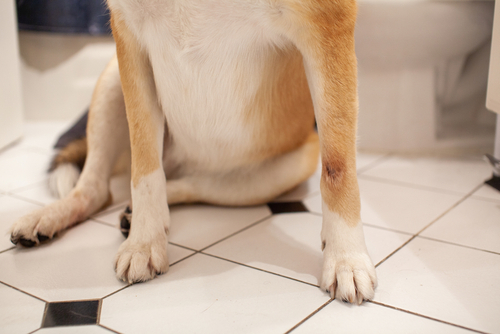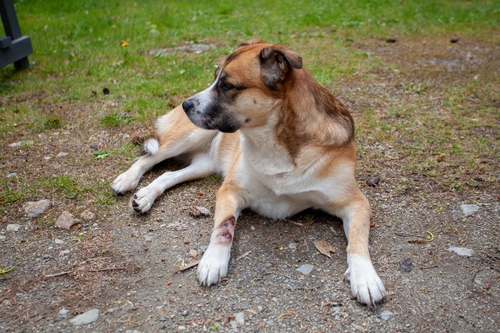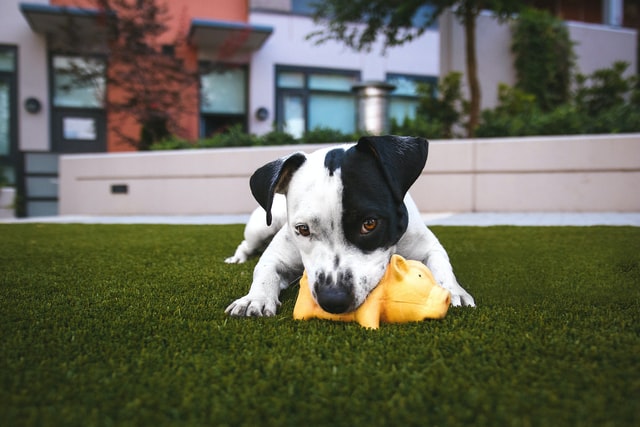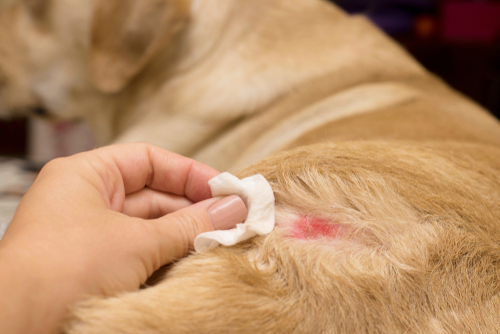Treating Hot Spots on Your Dog
Posted: 08/10/2022 | BY: Erin Cain | Categories: Dog , Health problems , Pet care
You notice that your dog is scratching at her sides one day, but dismiss it as just an itch. When you see her a few days later, scratching and chewing in that same location, you push aside her fur to find a large, red patch of skin that is inflamed and oozing. Your dog has a hot spot, a condition that commonly frustrates pup parents almost as much as their dogs. Treating hot spots on your dog is something that all pup parents can do with knowledge and practice, and a little help from your veterinarian.

What is a hot spot?
A hot spot, also known as moist pyotraumatic dermatitis, is a localized and painful skin inflammation and infection. While more common in breeds with thick fur, like Golden Retrievers and German Shepherds, any dog can develop a hot spot. There are certain places on a dog’s body that hot spots are more likely to occur:
- the side of the face
- the side of the body
- the neck
- the chest
- the hind end
- the paws
- the tail
Hot spots typically develop quickly and can grow from a small spot to several inches in diameter within 60 minutes with intense scratching. This action causes the site to become infected with bacteria, leading to painful, inflamed, oozing skin. The fur around the hot spot sticks to the sore, providing an ideal habitat for bacterial growth. The skin becomes warm due to the infection, which is why this injury is called a hot spot.
This skin infection only affects the top layer of skin, and if treated, they tend to heal quickly. However, large sores or those that don’t respond to treatment should be evaluated by your dog’s veterinarian.

What causes hot spots on dogs?
Hot spots can happen on any dog’s skin, but certain chronic conditions can make them occur more frequently in some pups than others. There are several causes for hot spots on dogs, including:
- food or environmental allergies
- flea or insect bites
- cuts, sores, or abrasions
- skin or ear infections
- contact irritants
- matted hair and poor coat condition
- psychological stress or anxiety, like boredom or separation anxiety
- anal sac infection or impaction
- moisture trapped in the fur from bathing or swimming
Flea and insect bites may lead to acute hot spots, meaning the sores usually heal in a short period. Chronic hot spots often indicate a more significant underlying concern, like allergies, psychological stressors, or an underlying illness or disease. Hot spots that appear chronically on your dog’s skin should be examined and evaluated by a veterinarian to assess the cause of the infections.

How to treat hot spots on your dog
There are a variety of ways to stop the itch and pain associated hot spots. Here are the steps to take to treat a hot spot:
1. Trim or shave the fur around the wound as close to the skin as possible.
The best first step to treating hot spots is to expose them to the air, so they dry out. As the infected area is likely sore and sensitive, be careful when you trim around it. If you are uncertain of your ability to clip the fur, or if your dog reacts poorly to your efforts, ask your veterinarian to do it for you.
2. Clean the area thoroughly.
Once you can see the sore itself, use cool water and a gentle cleanser to clean it. Consider using a wet sponge, wipe the area, get the sponge soapy and wipe again, then using a second sponge to rinse the hot spot off.
3. Apply over-the-counter or natural remedies to the area.
The third step allows for a variety of means to promote healing in the hot spot.
- Place a cool compress or used herbal black tea bag on the hot spot. A cool compress helps to soothe the itch and pain from the sore; apply it two to four times a day with a wet cloth. For the used black herbal tea bag, steep the tea bag in 8 ounces of hot water, then let it cool completely. Place the bag on the sore and apply it twice a day.
- Use a topical product like a spray with 5% benzoyl peroxide or hydrocortisone, an antiseptic, or special shampoo to protect and encourage healing of the wound. Non-toxic products, like Vetericyn, promote healing and are safe for your dog should she lick and ingest it.
- Prevent chewing, scratching, and licking of the hot spot. Some dogs can’t stop worrying at a hot spot, which can lead to more pain, itching, and infection. Use an e-collar to keep your dog away from the sore and give it time to heal.
Always speak with your veterinarian before applying new products to your dog’s skin, and especially to hot spots. Again, for chronic hot spots, see your veterinarian who can prescribe antibiotics for your pup.

Proactive ways to prevent hot spots
The best way to prevent hot spots is to determine the underlying cause responsible for their appearance. You may need the help of your veterinarian to find the reason for the hot spots, especially if they are chronic.
Frequent grooming and good hygiene can prevent dirt from becoming trapped in the fur and can stop hair mats from forming and irritating the skin’s surface.
If your dog bathes or swims frequently, take the time to thoroughly dry out her coat to prevent moisture against the skin, which can lead to hot spots
Flea and parasite allergy dermatitis can cause hot spots to occur. Use a veterinary recommended flea control to destroy and prevent fleas from irritating your dog’s skin.
For issues with dry, flaky skin causing frequent itching and hot spots, consider changing your dog’s diet with the advice of your veterinarian. You may also want to add essential fatty acids, like Omega-3 and Omega-6, either in your pup’s food or as a supplement. These fatty acids promote healthy skin and have anti-inflammatory properties.
Dogs who have hot spots due to stress, anxiety, and boredom need something to engage their mind and body. Give your dog more exercise throughout the week, or buy some enrichment toys or puzzles to keep your dog’s mind occupied, so she doesn’t fall into the habit of chewing on her paws.
Some research shows that over-vaccinating your pup may cause skin allergy issues, which in turn may lead to the development of hot spots. Speak with your veterinarian about which vaccinations are necessary for your dog so you can avoid this issue.

Keep your pup hot spot-free
When you notice your pup scratching or chewing frequently on part of her body, investigate that area for a hot spot. Acute hot spots can be treated at home, while your dog’s veterinarian should examine and diagnose chronic infection. By keeping a careful eye on your pup, and taking preventative steps, you can address any of your dog’s hot spot issues before they get out of control.
References:
- Grant, D. (2015). Pyotraumatic dermatitis( acute moist dermatitis, hot spot). Retrieved from https://veterinary-practice.com/article/pyotraumatic-dermatitis-acute-moist-dermatitis-hot-spot
- Lenox, C. (2020). Role of Dietary Fatty Acids in Dogs & Cats. Retrieved from https://todaysveterinarypractice.com/role-of-dietary-fatty- acids-in-dogs-cats/
- Rodier, L. (2010). Beware of Over-Vaccinating Your Dog. Retrieved from https://www.whole-dog-journal.com/health/beware-of-over-vaccinating-your-dog/
Disclaimer
The information contained on this blog is intended for informational and educational purposes only and should not be construed as medical advice. It is not a substitute for professional veterinary care. Always consult with your veterinarian before making any changes to your pet's health care or treatment plan.
The authors of this blog are not veterinarians and do not claim to be experts in pet health. The information provided here is based on our own experiences and research, as well as information from reputable sources. However, we cannot guarantee the accuracy or completeness of this information.
We encourage you to do your own research and consult with your veterinarian before making any decisions about your pet's health.
Previous post
Pet Separation Anxiety and COVID-19Next post
4 Dog Training Tips For Leash AggressionCompare top pet insurance providers plans.
Enter your dog’s age in years and months to calculate their age equivalent to human years.
Calculate your dog’s ageEnter your cat’s age in years and months to calculate their age equivalent to human years.
Calculate your cat’s age